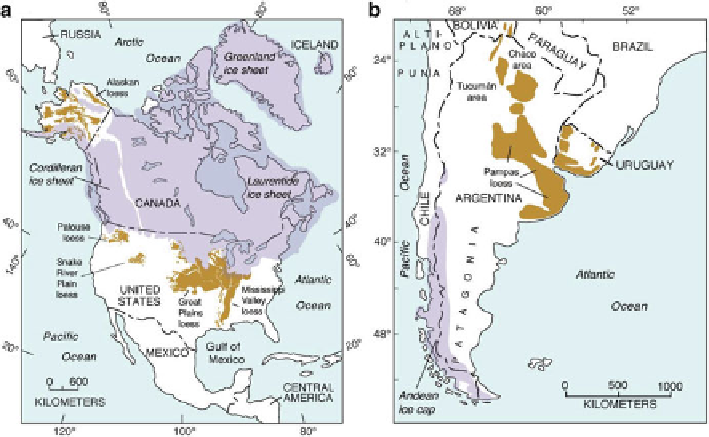Geoscience Reference
In-Depth Information
Fig. 16.4
(
a
) Distribution of loess in North America and the extent of ice sheets during the last
glacial period (
light purple
) (Redrawn from Péwé (
1975
), Bettis et al. (
2003
), Busacca et al. (
2004
),
and sources therein). (
b
) Loess distribution in South America and ice extent (
light purple
) during
the last glacial period (Redrawn from Zárate (
2003
,
2007
) and sources therein)
At lower latitudes in Europe, thick loess deposits have been described in the
Carpathian basin along the Danube River, corresponding to the succession of several
glacial-interglacial cycles (Markovic et al.
2006
,
2009
). The stratigraphy is much
different than is typically observed elsewhere in Europe, with the appearance of a
rather homogenous period of loess deposition (Antoine et al.
2009a
), including an
absence of the loess-paleosol doublets identified at localities in the 50
ı
N latitude
loess belt. The environmental conditions appear to have been much drier during
the whole last climate cycle, with conditions again allowing the occurrence and
development of C
4
plants, indicative of vegetation living under severe moisture
stress (Hatté et al.
2013
).
16.8.2
Africa and the Middle East
Loess in Africa and the Middle East is not as extensive and thick as in Europe
and in North America: it is patchy in nature (Fig.
16.6
). Yet loess is the parent
material for some of the most fertile soils in these regions. A few characteristics are
common to all reported desert loess sites in Africa and the Middle East (following
Crouvi et al. (
2010
)): (1) loess bodies are located in semiarid to subhumid climate

Search WWH ::

Custom Search